 |
| The Devil’s Bath directors Veronika Franz and Severin Fiala with Anne-Katrin Titze: “The film takes place in a time when Enlightenment was starting, but still a lot of superstition was going on.” |
Veronika Franz and Severin Fiala’s The Devil's Bath (Des Teufels Bad, a highlight of the 23rd edition of the Tribeca Film Festival), starring Anja Plaschg (who is also the composer as Soap&Skin) with Maria Hofstätter and David Scheid, shot by Martin Gschlacht (Silver Bear winner in the 2024 Berlin Film Festival) with costumes by Tanja Hausner (Jessica Hausner’s sister and longtime collaborator) is executive produced by Ulrich Seidl (Rimini and Sparta) and Bettina Brokemper (Margarethe von Trotta’s Ingeborg Bachmann - Journey Into The Desert, starring Vicky Krieps and Ronald Zehrfeld).
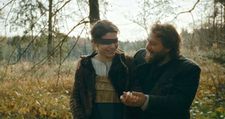 |
| Agnes (Anja Plaschg) being led blindfolded by her husband Wolf (David Scheid) to where they will live |
Agnes (Anja Plaschg), wearing a thick brown woolen sweater, braids a fragile wreath for her hair and wraps her precious collection of dried grasses, insects and shells into a kerchief. This is her wedding day and together with her mother, brother, and a chicken, they are off through the woods to celebrate. Wolf (David Scheid),the groom, drinks and laughs with his male friends until it is time to lead Agnes to their new abode, a gloomy old stone hut, dark and uninviting, and so costly that it ate up everything they had, including the dowry.
The new mother-in-law (a brilliantly menacing Maria Hofstätter) is a controlling force not only in this household, but in the village as well. She hands out the bread to the workers at the lake, one piece each, even for the very hungry or very pregnant. A chopped-off finger or toe from an executed woman increases fertility. Cooking and recipes are timed by the length of prayers - three more Pater Nosters and the soup is done!
The horror in Franz and Fiala’s third feature together (following Goodnight Mommy and The Lodge) is very much of this world and rooted in a belief system that brought hundreds of women “weary of this life” to commit acts of murder and confess, so as to be forgiven and spared eternal condemnation. Based on historical records from mid-18th century Upper Austria, The Devil’s Bath drops us into a rural society with strict codes governing the here and the hereafter.
From New York, during the Tribeca Festival, Veronika Franz and Severin Fiala joined me on Zoom for an in-depth conversation on The Devil’s Bath.
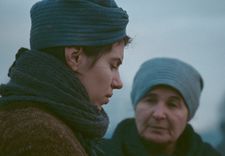 |
| Agnes (Anja Plaschg) with her mother-in-law (Maria Hofstätter) |
Anne-Katrin Titze: Good to see you both again in New York! I noticed that you were framing this film with children. In the beginning there is the boy who does shadow puppetry on the laundry line. In the end you show the little girls playing, and especially the one who sings with Agnes. This makes for such an interesting frame. Can you tell me about that?
Severin Fiala: I think that’s a very good observation. It’s maybe different reasons for kids being there in the end of the film. In the beginning we just really liked the idea that it’s such a cinema image with this shadow play on white linen. That is really related to cinema, to silent film, an ancient predecessor of cinema.
AKT: Lotte Reiniger’s shadow puppet films came to my mind.
SF: Yes! Thank you very much! The girl in the end, I think, is something pointing into the future. Agnes at the moment of her execution is connected or connects with this young girl whose future is the unknown. And the question is, will she be able to come out of this, let’s say, vicious cycle. Can she escape the pressures that society and religion put on her? Or is she going to have a similar fate than Agnes?
Veronika Franz: To me it’s also like the daughter she could have had maybe. Or the moment that she is not alone. Because, you know, the girl joins her by singing the same song. I liked it very much because it has very different aspects. It’s like a consolation. They are both together in this moment. She’s a girl, and Agnes does not see, she only hears, her voice. On the other hand, she may just be the next murderer. We liked the complexity of this bond.
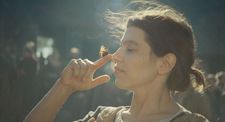 |
| Anja Plaschg as Agnes, who was also the film’s composer as Soap&Skin |
AKT: I loved it because there is so much depth to this moment. Also the idea of how this was so clearly a different time and a different normal. A normal that included going to “events” like that. When we spoke about Goodnight Mommy years ago, you mentioned exactly the plot of The Devil’s Bath and the research by Kathy Stuart. Before we get to the “suicide by proxy”, maybe we can touch on some of the other elements that were so interesting, that I had never heard of before. For instance that people took fingers and toes of executed women because they had special powers of fertility?
VF: Yes!
SF: It’s like that. The film takes place in a time when Enlightenment was starting, but still a lot of superstition was going on. It was this discrepancy that we liked. It’s part of the joy of making a film, that you can dive into a topic, a subject that you are interested in and then you just find out as much about it as you can. We specifically researched executions and superstition and all this medical history of that time. And there were lots of very unexpected, great, and very cruel things they came up with. We hadn’t heard about any of those either but were very intrigued by it. The most common medical treatment back in the time when the film is set was bloodletting.
AKT: Leeches?
VF: That also.
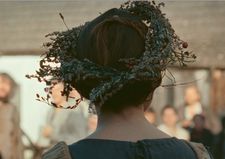 |
| Agnes (Anja Plaschg) at her wedding |
SF: Drawing blood mainly, because they thought it helped, that’s the most common thing. That’s the only one we would have known about and that’s why it ends up being in all those films, because it’s the most obvious one. We tried to look into it more deeply in order to come up with other treatments that are more visually unusual. That was part of the fun.
VF: The cut-off fingers, for example, could not only help for fertility, but also augment things. So they would put them in beer barrels so that they would sell more beer. They had different options for cut-off fingers! The drinking of blood was supposed to heal, to cure diseases, especially depression. It’s also kind of ironic, or grotesque that people would go there to get some blood from executed women as a cure against depression, while at the same time they realised that they could also commit the same crime to commit suicide and go to Heaven.
AKT: Before the execution she is sewn into an animal skin alive and dragged to the place. This is also historically documented?
SF: Yes, at the time our movie is set, they started to realise that there was an increase in those crimes, women murdering children. The first attempt to prevent those crimes was to make the death sentence even more extreme. This was a ritual they did before the execution that was meant to humiliate those to be executed by making it even more shameful. An even harder punishment than being just executed. But it didn’t work at all because sometimes those people wanted to repent for their sins. Of course they did a confession with a priest but they also wanted to repent for their sins, so they were actually kind of happier, the harder the punishment was. Then the chance they would go to Heaven was even higher.
 |
| The Devil’s Bath drops us into a rural society with strict codes governing the here and the hereafter. |
AKT: The film takes place in 1750. The first collection of tales by the Brothers Grimm was published in 1812. A lot of tales feature elements of what you are showing. With the animal skin, for example, even Little Red Riding Hood and Grandma coming out of the Wolf share that imagery. And tales like All Fur, where a princess disguises herself as an animal to escape. Even the cut-off finger plays a role in The Robber Bridegroom.
VF: That’s true! Have you ever read the original version of the Grimm Brothers?
AKT: Yes!
VF: Because I tried. I wanted to read them to my children and bought the original ones. I stopped reading because they are so cruel and they are so literate that you can’t read them to a five-, or a seven-year old.
AKT: Because they weren’t meant for children and started out as scholarly editions! Folktales and religion were, of course, always overlapping. I loved the moment in your film when they were saying prayers to time the cooking. How many Pater Noster does it take to make this stew?
SF: That’s something they did! That’s also the joy of research, we hadn’t heard of this either, but it makes total sense. There was no other way to measure at the time. We found it very funny that it was religious but that those prayers also had a very down-to-earth meaning to measure time. This absurdity also spoke to us.
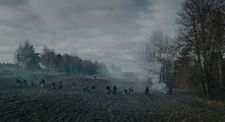 |
| Veronika Franz on Maria Hofstätter: ”She was involved in the script very early on because she has a background in a farmer family.” |
AKT: Talking about cooking and before we speak about your star, I want to mention Maria Hofstätter, who is fantastic as the mother-in-law!
VF: Thank you!
AKT: I felt I knew this character, I don’t know why. She is so steeped in that world and also is the one who had to take control. She hands out the bread to everyone and we wonder what life she must have led to get to this point. The performance is fantastic!
VF: We always wanted to avoid the cliché, the tale cliché of the bad mother-in-law, so one of the ideas was that she’s from a different generation and she has her values. She has also to keep up the morals in this society. We actually owe Maria Hofstätter a lot. She was involved in the script very early on because she has a background in a farmer family. She comes from the “Bauernhof” and she also cooked for us this typical farmers’ porridge thing and told us whenever we made mistakes. What we learned from her was that it should always be about the work, and doing the work right.
SF: Practicality!
VF: Yes, it’s about practicality. For example in the beginning the costume was too long and she tried her dress and said, I cannot work in this dress! She also helped us audition. So when we auditioned the main actress, she would come and play the mother-in-law and I think it was also a way for her to find this character.
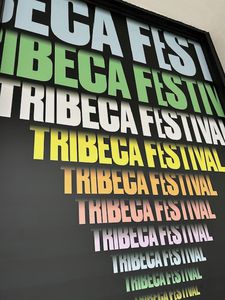 |
| The Devil's Bath is a highlight of the Tribeca Festival Photo: Anne Katrin Titze |
SF: We tried to work against cliché and with Maria together we tried to find something more human and find all the pressure that society put on her. Looking at her, you are talking about her family as well and she is under a lot of pressure to make this woman [Agnes] work. I think that makes her more of a human being.
VF: She also wants to do things right. She cares. You mentioned the Pater Noster - it was very difficult to use that in the scene because it always felt dry or artificial. But the more she used it, the better she found a way to use it very naturalistically.
SF: Usually we’re not rehearsing in a very classical way, going through a specific scene with the exact lines. But we had Maria and also Anja sleep in those houses, they cooked, they did the work, the fishing, all the physical stuff. They had the clothes on. It felt natural for them. I think it’s more important to us this process so that they get to know their world that should feel or become natural to them.
AKT: I noticed a name in the thanks and I think I knew her mother - Sophie Strohmeier.
SF: Yes, we met with her yesterday.
VF: She lives in New York actually. She’s half American, half Austrian.
SF: Funnily enough, how we came across this whole theme is due to Sophie. I met her in the very small town where I’m originally from and she and her friend were passing through and she called me and asked me if I was there, which I never was. It was pure coincidence that I was there and we wanted to grab a coffee and I knew that Sophie was interested in morbid and dark stories. So I went with them to a place where the owner had hung himself in the café. I knew that story because I used to be a paramedic. I told them the story and then Sophie said, ah suicide, she recently heard an amazing podcast episode on a phenomenon, called suicide by proxy. She was actually the one who brought up the whole thing and brought it to our attention.
VF: Did you know the mother? Was she the Austrian or American part?
SF: Not personally.
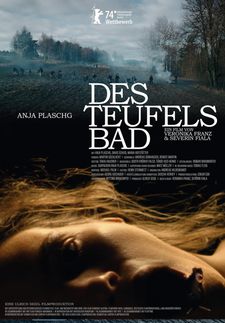 |
| Des Teufels Bad poster |
AKT: Her mother, Hillary, was American. She was a colleague of mine at Hunter College, teaching German Fairy Tales and very interested in witchcraft!
VF: Ah!
AKT: That’s how I know her mother! You had mentioned another project about the last executioner of Vienna. Is that still in your future?
VF: We stopped writing it because we could not find the right angle to tell the story.
SF: We were lazy and thought we would give it to another writer who would continue the work while we were working on The Devil’s Bath or something else, but so far nobody has really managed to develop this in the direction that would be interesting for us. We think back to it every now and then, it’s definitely not totally gone and there will be a moment for it.
AKT: Thank you so much!
SF & VF: Thank you!
Coming up - Veronika Franz and Severin Fiala on The Devil’s Bath star Anja Plaschg, who also is the film’s composer as Soap&Skin, Tanja Hausner’s costumes, Martin Gschlacht’s cinematography with mainly natural light, and giving back to the past.
The Devil’s Bath is available on Shudder starting on Friday, June 28 and is screening in cinemas in the US now.





















